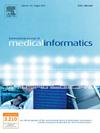利用机器学习预测急诊科热相关疾病患者的死亡率
IF 3.7
2区 医学
Q2 COMPUTER SCIENCE, INFORMATION SYSTEMS
International Journal of Medical Informatics
Pub Date : 2025-04-26
DOI:10.1016/j.ijmedinf.2025.105951
引用次数: 0
摘要
在气候变化和全球变暖的背景下,热相关疾病(HRI)预计将升级并成为一个主要关注的问题。严重HRI患者主要出现在急诊科(ED),但没有预测HRI患者急诊科死亡率的工具。本研究的目的是利用机器学习方法建立HRI患者急诊科死亡率的预测模型。方法我们纳入了所有20岁及以上最终诊断为HRI的患者,这些患者就诊于三家医院的急诊科(奇美医疗中心、柳营奇美医院、柳营奇美医院)。和奇美医院(Chiali)),期间为2010年1月至2021年10月。转移到其他医院或资料不足的患者被排除在外。算法共使用了11个预测特征变量。主要结局是住院死亡率或即将死亡出院。我们使用了包括逻辑回归(LR)、随机森林(RF)、支持向量机(SVM)、光梯度增强机(LightGBM)、多层感知器(MLP)和极端梯度增强(XGBoost)在内的机器学习算法来建立这类患者死亡率的预测模型。以准确性、敏感性、特异性和曲线下面积(AUC)作为评价预测模型性能的指标。结果在纳入分析的820例HRI患者中,1.5%有死亡率。6种预测模型的AUC均较高,范围在0.825 ~ 0.991之间,其中包括外周氧饱和度(SpO2)和格拉斯哥昏迷量表(GCS)评分的LightGBM模型的AUC最高。LightGBM的准确度为0.976,灵敏度为1.000,特异度为0.975。结论基于机器学习的预测模型是准确预测急诊科HRI患者死亡率的有效工具。本文章由计算机程序翻译,如有差异,请以英文原文为准。
Utilizing machine learning for predicting mortality in patients with heat-related illness who visited the emergency department
Background
In the context of climate change and global warming, heat-related illness (HRI) is anticipated to escalate and become a major concern. Patients with severe HRI primarily present to the emergency department (ED), but there are no prediction tools for mortality in HRI patients who visit ED. The objective of this study was to use machine learning approaches to establish prediction models for mortality in patients with HRI who visit ED.
Methods
We included all patients aged 20 and above with a final diagnosis of HRI who visited the EDs of three hospitals (Chi Mei Medical Center, Chi Mei Hospital Liouying, and Chi Mei Hospital Chiali) between January 2010 and October 2021. Patients who had transferred to other hospitals or had insufficient data were excluded. A total of 11 predictive feature variables were used in the algorithms. The primary outcome was in-hospital mortality or impending death discharge. We used machine learning algorithms including Logistic Regression (LR), Random Forest (RF), Support Vector Machine (SVM), Light Gradient Boosting Machine (LightGBM), Multilayer Perceptron (MLP), and eXtreme Gradient Boosting (XGBoost) to establish prediction models for mortality in such patients. Accuracy, sensitivity, specificity, and area under curve (AUC) were used as indicators to evaluate the performance of prediction models.
Results
Out of the 820 HRI patients included in the analysis, 1.5% had mortality. All six prediction models had a high AUC, ranging from 0.825 to 0.991, and LightGBM which included peripheral oxygen saturation (SpO2) and Glasgow Coma Scale (GCS) score on arrival as the two main features had the highest AUC. The accuracy, sensitivity, and specificity of LightGBM were 0.976, 1.000 and 0.975, respectively.
Conclusion
Machine learning-based prediction models are promising tools in accurately predicting mortality in HRI patients who present to the ED.
求助全文
通过发布文献求助,成功后即可免费获取论文全文。
去求助
来源期刊

International Journal of Medical Informatics
医学-计算机:信息系统
CiteScore
8.90
自引率
4.10%
发文量
217
审稿时长
42 days
期刊介绍:
International Journal of Medical Informatics provides an international medium for dissemination of original results and interpretative reviews concerning the field of medical informatics. The Journal emphasizes the evaluation of systems in healthcare settings.
The scope of journal covers:
Information systems, including national or international registration systems, hospital information systems, departmental and/or physician''s office systems, document handling systems, electronic medical record systems, standardization, systems integration etc.;
Computer-aided medical decision support systems using heuristic, algorithmic and/or statistical methods as exemplified in decision theory, protocol development, artificial intelligence, etc.
Educational computer based programs pertaining to medical informatics or medicine in general;
Organizational, economic, social, clinical impact, ethical and cost-benefit aspects of IT applications in health care.
 求助内容:
求助内容: 应助结果提醒方式:
应助结果提醒方式:


